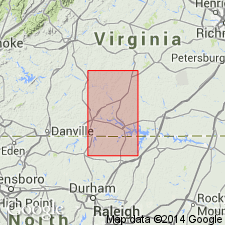
- Usage in publication:
-
- Buffalo granite
- Modifications:
-
- Named
- Dominant lithology:
-
- Granite
- AAPG geologic province:
-
- Piedmont-Blue Ridge province
Summary:
Buffalo granite occurs as small masses or areas of a coarse, porphyritic intrusive granite, with very large feldspar phenocrysts, Redoak granite in vicinity of Buffalo Lithia Springs, Mecklenburg Co., south-central VA. It is light gray, coarse-grained, and differs from main granite masses of Virgilina district very little except in texture. Age is Precambrian.
Source: GNU records (USGS DDS-6; Reston GNULEX).

- Usage in publication:
-
- Buffalo granite
- Modifications:
-
- Overview
- AAPG geologic province:
-
- Piedmont-Blue Ridge province
Summary:
Buffalo granite used as informal unit on the State map. Described as light-gray, coarse-grained, porphyritic granite to granodiorite. Predominant minerals are quartz, potassium feldspar, plagioclase and biotite. Accessories include apatite and zircon. Hydrothermal alteration to sericite, epidote, kaolin, and chlorite common. Unit part of Clarksville batholith of Horton and others (1993).
Source: GNU records (USGS DDS-6; Reston GNULEX).
For more information, please contact Nancy Stamm, Geologic Names Committee Secretary.
Asterisk (*) indicates published by U.S. Geological Survey authors.
"No current usage" (†) implies that a name has been abandoned or has fallen into disuse. Former usage and, if known, replacement name given in parentheses ( ).
Slash (/) indicates name conflicts with nomenclatural guidelines (CSN, 1933; ACSN, 1961, 1970; NACSN, 1983, 2005, 2021). May be explained within brackets ([ ]).

